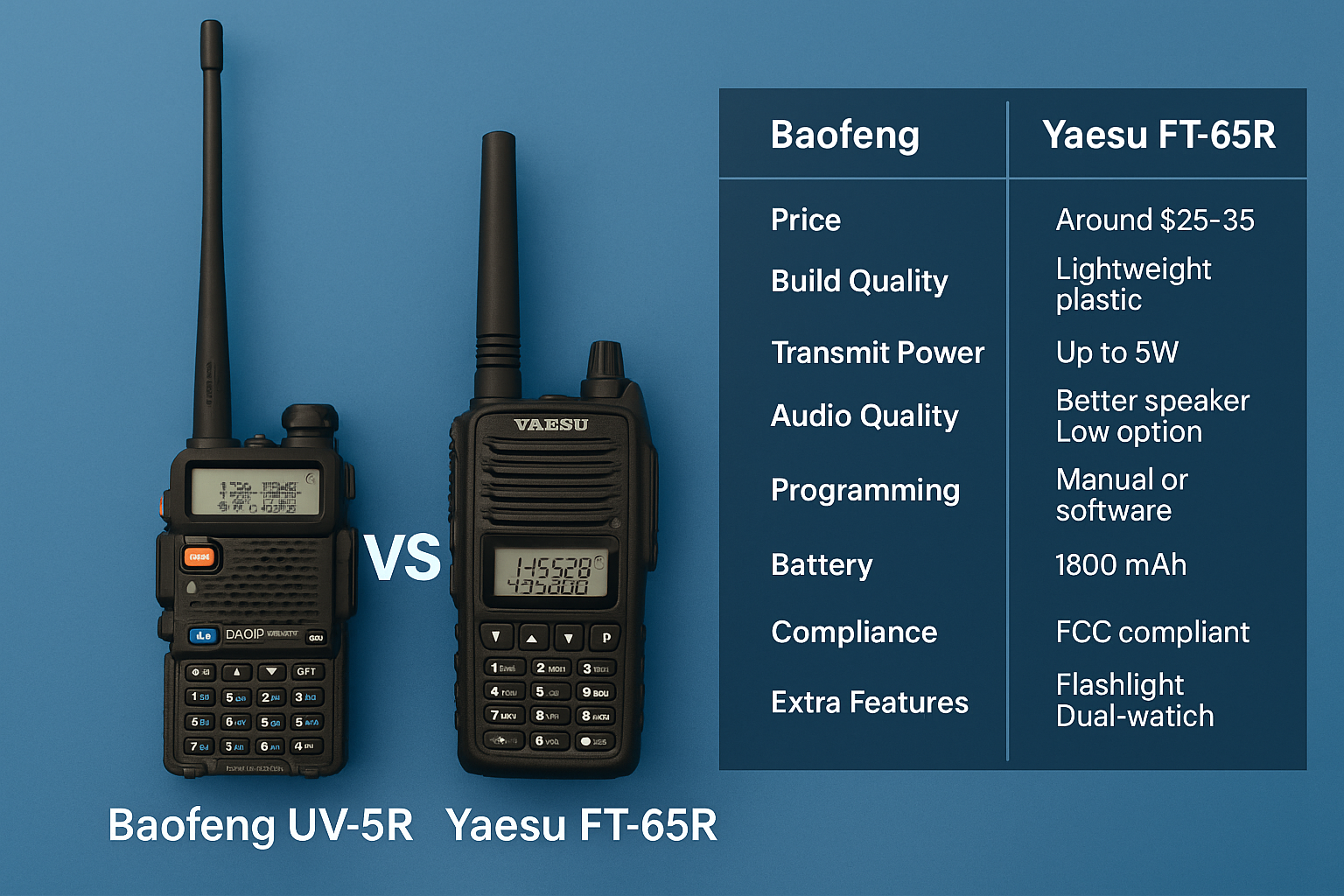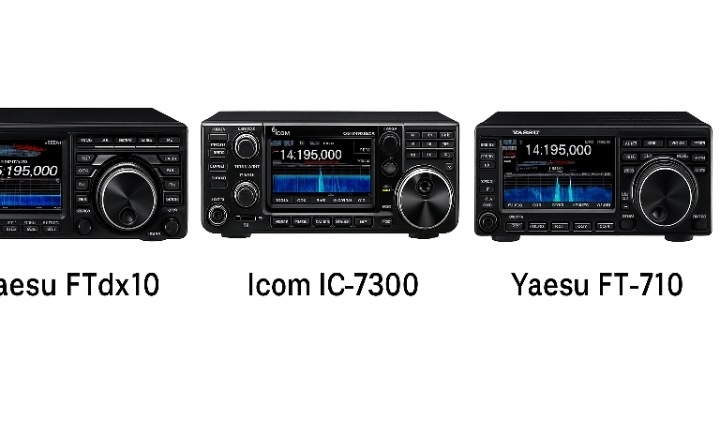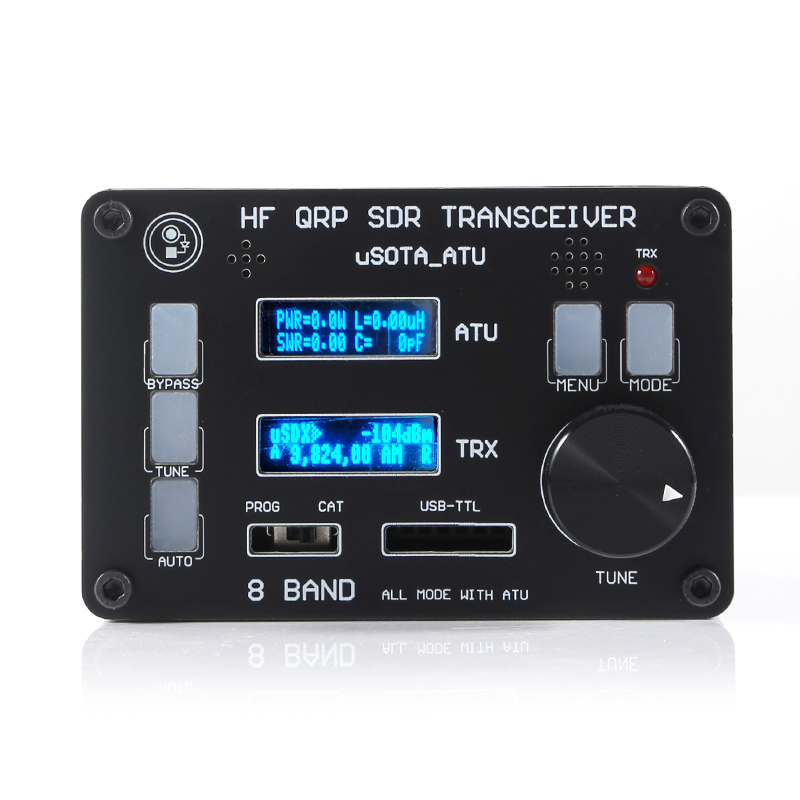When you’re just getting into ham radio or looking for a reliable backup handheld, two names often pop up: the Baofeng UV-5R and the Yaesu FT-65R. Both radios are dual-band handheld transceivers (HTs) and are priced affordably, but they appeal to slightly different types of users.
So, how do these two radios compare? Which one is better suited for your needs? Let’s break down the key differences and similarities to help you decide.
Price and Value
The Baofeng UV-5R is the most budget-friendly ham radio on the market. You can usually find it for around $25 to $35. It’s an unbeatable deal for a dual-band HT with accessories included—battery, charger, antenna, and earpiece.
The Yaesu FT-65R is priced higher, typically between $90 and $110. While it’s still considered affordable for a quality radio, it costs about three times as much as the UV-5R. However, it comes from a well-established brand and offers higher reliability and quality assurance.
Winner: Baofeng UV-5R (on price)
Build Quality and Durability
The UV-5R is lightweight, with a plastic body that can feel a bit flimsy. It’s fine for light use, but it may not withstand heavy-duty wear and tear.
The FT-65R, on the other hand, is built to commercial standards. It’s solid and rugged, with an IP54 rating for dust and water resistance. If you need a radio that can survive rough handling, outdoor use, or emergency situations, Yaesu is the better choice.
Winner: Yaesu FT-65R
Transmit Power
Both radios offer up to 5 watts of power, which is standard for handhelds. The Yaesu gives you three selectable power levels (0.5W, 2.5W, 5W), while the Baofeng offers just low (1W) and high (5W) settings. This extra flexibility helps with battery management.
Winner: Yaesu FT-65R (for power control)
Audio Quality
The FT-65R has noticeably better speaker and microphone performance. Its 1-watt speaker delivers loud and clear audio, even in noisy environments. The UV-5R’s audio can sound weaker or distorted at higher volumes, and many users upgrade the mic to improve it.
Winner: Yaesu FT-65R
Programming and Usability
Programming both radios by hand can be a bit of a challenge, especially for beginners. However, both can be programmed via software, and Baofeng’s UV-5R has an edge due to broad CHIRP support and easy-to-find cables and guides.
The FT-65R also supports CHIRP and has its own official software, but the programming cable is sold separately and can be harder to source.
Winner: Slight edge to Baofeng UV-5R
Battery Life and Accessories
The UV-5R typically ships with an 1800mAh battery, with optional 3800mAh extended batteries widely available. Accessories are cheap and plentiful, including antennas, mics, and chargers.
The FT-65R includes a 1950mAh battery, and you can buy a 2500mAh upgrade. Battery life is solid, but accessories are more expensive and less varied than with the Baofeng.
Winner: Baofeng UV-5R (for accessories and battery flexibility)
Compliance and Safety
One major downside of the UV-5R is that it often fails to meet FCC emissions standards. While it’s legal to use on amateur bands, it’s easy to transmit on restricted frequencies by accident. That’s a big concern if you’re serious about compliance or operating in emergency situations.
The FT-65R, on the other hand, is fully FCC-compliant and has better harmonic suppression. It’s safer and more appropriate for official or professional use.
Winner: Yaesu FT-65R
Extra Features
The Baofeng UV-5R includes a built-in flashlight, FM radio receiver, and dual-watch mode. These extras are great for general-purpose use or as an emergency radio.
The FT-65R also includes an FM radio and has a loud emergency call button but lacks the flashlight or dual-watch capability.
Winner: Tie – Baofeng for features, Yaesu for reliability
Final Verdict
Choose the Baofeng UV-5R if:
- You’re new to ham radio and want to learn on a budget
- You need multiple radios for a group or family
- You’re building an emergency kit and need affordability and volume
- You’re comfortable programming and tweaking things
Choose the Yaesu FT-65R if:
- You want a more rugged, reliable radio for daily use
- You care about compliance and performance in emergency situations
- You want better audio and fewer signal quality issues
- You plan to use your radio in the field or professionally
Conclusion
Both radios have a place in the ham radio world. The Baofeng UV-5R is a fantastic learning tool and low-cost option that lets you experiment and get involved in amateur radio. The Yaesu FT-65R, while more expensive, delivers superior build quality, performance, and safety—perfect for serious operators and preppers who don’t want to compromise.
At the end of the day, your choice depends on your goals and how much you’re willing to invest. For some, the UV-5R is enough. For others, the FT-65R is worth the upgrade.
Have you used either of these radios? Which one do you prefer, and why? Drop your thoughts in the comments below!



